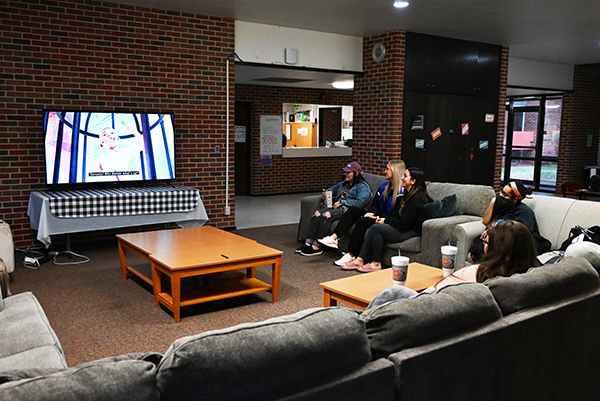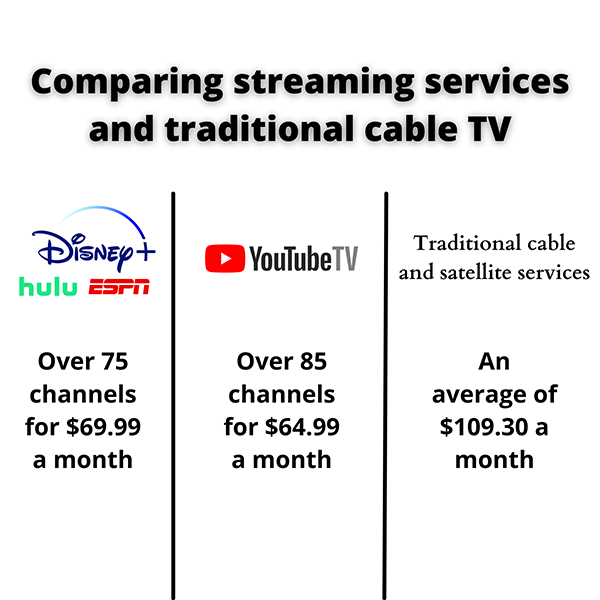Streaming services replacing cable, satellite television
By CAITLIN HOFEN, Features Editor

The satellite dish swung along the side of the house, a single cord suspending it in the air.
Inside, the television program cut in and out as the wind blew the satellite faster. With a loud snap, the satellite fell to the ground and the TV went to static.
Problems like these are a downside to using services like cable and satellite television.
However, a popular alternative has been growing since the early 2000s: streaming services. Popular movies, TV shows, sporting events and news are offered on-demand without a cable or satellite service requirement, thus replacing the need for cable and satellite television.
All that is necessary to use streaming services is a good internet connection and a smart TV with the streaming apps built in, or an inexpensive streamer like an Amazon Fire TV Stick or Roku, according to David Katzmaier, editorial director of TVs and streaming at www.cnet.com.
Some popular streaming services are Netflix, Hulu, Disney Plus and Amazon Prime Video.
SAVING MONEY
Many of these services offer different package levels based on cost and number of users.
“Overall, streaming is cheaper than cable,” said Jeffery Cher-Aime, a senior at Northwestern. “You aren’t paying for a bunch of channels you’ll never watch. My family in America doesn’t have cable anymore because the streaming apps are built into the TV. The apps have free trials, which you use and get a taste of what shows they offer. You can also pick and choose what to watch when you want it, instead of watching whatever happens to be on at that time.”
A native of the Bahamas, Cher-Aime said hardly anyone on the islands has cable anymore because of the measures it takes to distribute such services.
“We have to run long power cords along the ocean floor to get electricity to every island,” Cher-Aime said. “Therefore, it’s easier to get satellite internet and stream TV and movies than trying to run cable lines from island to island.”
TRADITIONAL TV SEES SHARP DECLINES
According to an article written in the New York Times, “Cutting the Cord: Alternatives to Cable and Satellite TV,” Americans are using streaming in records numbers.
“As recently as 2010, more than 88 percent of households were paying for TV from a cable, satellite, or other provider,” according to the story. “But by the middle of 2015 that number had fallen to 80 percent.
And by the second quarter of 2016, it was reported that more people quit paying for TV service in the those three months than in any previous quarter.”
Because of the gradual migration from cable to streaming services, many popular networks and media companies have developed their own streaming services to reach a larger audience, both online and through satellite and cable.
According to its website, Discovery Plus offers almost all television shows shown on HGTV, Food Network and the Travel Channel.
NBC created Peacock, a streaming service with its network shows, in July 2020.
These networks heavily advertise their streaming services to attract cable and satellite viewers to watch episodes sooner online.
Other major networks are following suit and developing their own streaming services for consumers to watch television shows through.
CONVENIENCE OFFERED BY STREAMING
An appealing aspect of cable and satellite television is watching live events and shows.
However, many streaming services offer live TV add-ons to basic packages for consumers.
Aside from live TV, streaming services allow consumers to choose when and what they want to watch.
With no traditional scheduled programing, streaming service consumers have no limit to the time they have to watch a show or movie. Shows can pause or play at any time and pick up where the viewer left off.
Braylon Bradt, a junior at Northwestern, said he likes the portability offered with streaming services.
“A lot of streaming services have downloaded apps, and since I work outside most of the time, I’m able to choose a show I want to watch or listen to,” Bradt said. “It allows me freedom to enjoy my shows wherever I want, not just inside my house.”
Consumers have a choice in what shows they watch.
An article posted by bbntimes.com said this allows viewers to binge-watch their favorite shows, re-watch old episodes or movies and try out new shows. Some streaming services produce their own original productions to watch, including Hulu and Netflix.
“With all the different streaming options available, I can pretty much watch anything,” Bradt said. “When working long hours during harvest, a good show helps pass time.”
As with many apps, streaming service apps allow consumers to watch shows from anywhere with a network connection, including smartphones, tablets and computers.
An article posted by cnet.com said cable and satellite television services require multiple connections to physical televisions via cables and receiving boxes. This limits the mobility and access consumers have to watch TV.
Streaming apps are available in device app stores. Most are free to download and have optional in-app purchases.
The downside to replacing cable or satellite television with streaming services is the number of services available.
By having popular shows and movies limited to one platform, consumers are forced to pay for multiple services to watch all their favorite content.
While consumers must carefully consider which platforms to pay for, no long-term contracts are required for streaming services.
Most offer free trials with no fee to opt-out of the service once the trial is up.
According to an article on bbntimes.com, many cable and satellite services require a contract of one year or more to pay the lower advertised price.
If customers want to break the contract or change their package option, they must first pay heavy fees and sometimes continue paying for the service after the contract is broken.
Rented equipment, like cables, receiving boxes and satellites must be removed and returned to the company, or the consumer faces more fines.
As more and more people choose to stream their favorite TV shows and movies, the need for cable and satellite television declines.

